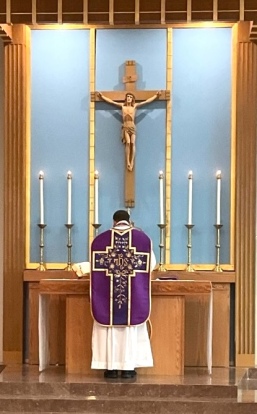 One of the first things a visitor to our Mass might notice is that the Celebrant is standing on the same side of the Altar as the people and has his back to them a fair amount of the time during Mass; the technical term for this is worship “ad orientem” (that is, “towards the East,” where the sun rises and from which Scripture says Christ will return: many churches were built so the Altar faced this direction). Older Catholics may remember the practice from pre-Vatican II days; younger ones may never have seen it. This ancient way of celebrating Mass has been an emotional issue over the past fifty years; many have said — and still say — it is a hindrance to the people’s active participation in the liturgy, frequently adding that it makes attending Mass more boring because “there’s less to see.” This sounds reasonable; so some (particularly those to whom the practice is unfamiliar) may well wonder why we celebrate our Mass this way?
One of the first things a visitor to our Mass might notice is that the Celebrant is standing on the same side of the Altar as the people and has his back to them a fair amount of the time during Mass; the technical term for this is worship “ad orientem” (that is, “towards the East,” where the sun rises and from which Scripture says Christ will return: many churches were built so the Altar faced this direction). Older Catholics may remember the practice from pre-Vatican II days; younger ones may never have seen it. This ancient way of celebrating Mass has been an emotional issue over the past fifty years; many have said — and still say — it is a hindrance to the people’s active participation in the liturgy, frequently adding that it makes attending Mass more boring because “there’s less to see.” This sounds reasonable; so some (particularly those to whom the practice is unfamiliar) may well wonder why we celebrate our Mass this way?
The people gathered for Mass have come to do something, not watch something; indeed, the word liturgy means “the work of the people.” It is true our liturgy is a performance, of a kind — but it is a performance in which we are the actors, and God is the “audience.” If the Holy Sacrifice of the Mass is considered this way the position of the Altar and Priest in ad orientem worship becomes much easier to understand. Put simply, he is not “turning his back to the people;” rather both he and the people are facing God: the Priest is in the same position they are. When worshiping in this way the special nature of the Priest’s role also becomes obvious to our senses: like the Priests of the Old Testament, he is a representative standing for and before the people — between themselves and the Holy of Holies — praying for them and offering their sacrifice in a unique and consecrated way. Ad orientem worship reflects this spiritual reality physically: the Priest either stands before the people to address God for them and himself, or turns towards the people to address them directly or bring them the Word of God. This, then, is the logic on which ad orientem worship rests.
The deepest root is the practice of those same Old Testament Priests: Christianity is a successor to Judaism and all the first Christians were devout Jews, so it is unsurprising that Jewish worship influenced the formation of Christian liturgy. From about the eighth century almost all Masses were celebrated ad orientem; and, from the earliest period, the people all turned to face the same direction as the Priest at the prayers of Consecration, no matter how they were arranged before it. The Second Vatican Council introduced the innovation of a free-standing Altar and permitted celebration of Mass facing the people (“versus populum”) in the 1960s. This decision (like most of their changes, grounded in the Council Fathers’ desire to fashion Catholic worship on the earliest models) was based on a then-current belief the earliest Christian churches had free-standing Altars (further archeological research seems to show that this was not the case). In practice what was permitted as an exception swiftly became universal and therefore many Roman Catholics today have never experienced ad orientem worship. This usage, however — like many other aspects of traditional Catholicism — was preserved in the Anglican communion. Saint Athanasius, following Pope Benedict’s express mandate to maintain our Anglican Patrimony and enrich the Church by it, now returns this ancient custom of the Church to the Church. Come, worship with us, and — after considering the rationale and Biblical history on which it rests — discover whether our ad orientem worship might become an addition to your sense of active participation in the Holy Sacrifice of the Mass.
